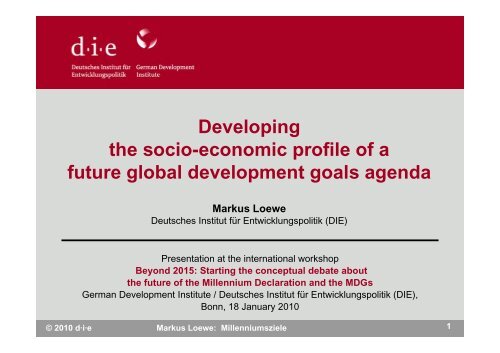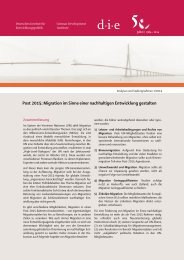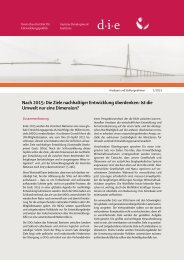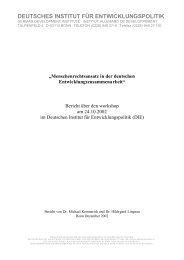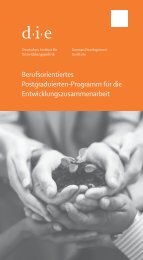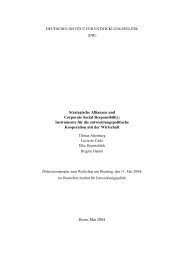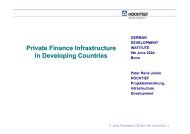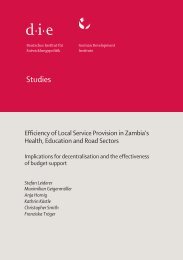Markus Loewe - Deutsches Institut für Entwicklungspolitik
Markus Loewe - Deutsches Institut für Entwicklungspolitik
Markus Loewe - Deutsches Institut für Entwicklungspolitik
Create successful ePaper yourself
Turn your PDF publications into a flip-book with our unique Google optimized e-Paper software.
Developing<br />
the socio-economic profile of a<br />
future global development goals agenda<br />
<strong>Markus</strong> <strong>Loewe</strong><br />
<strong>Deutsches</strong> <strong>Institut</strong> <strong>für</strong> <strong>Entwicklungspolitik</strong> (DIE)<br />
Presentation at the international workshop<br />
Beyond 2015: Starting the conceptual debate about<br />
the future of the Millennium Declaration and the MDGs<br />
German Development <strong>Institut</strong>e / <strong>Deutsches</strong> <strong>Institut</strong> <strong>für</strong> <strong>Entwicklungspolitik</strong> (DIE),<br />
Bonn, 18 January 2010<br />
© 2010 2008 d·i·e <strong>Markus</strong> <strong>Loewe</strong>: Die Millenniumsziele Millennium Development Goals<br />
1
Questions<br />
– What are the strengths of the Millennium Development Goals<br />
(MDGs)?<br />
– What are their weaknesses?<br />
– Which goals from the field of socio-economic development<br />
might be added to the MDGs?<br />
© 2010 2008 d·i·e <strong>Markus</strong> <strong>Loewe</strong>: Die Millenniumsziele Millennium Development Goals<br />
2
Millennium Development Goals<br />
7. Ensure<br />
environmental<br />
sustainability<br />
8. Develop<br />
a global<br />
partnership for<br />
development<br />
6. Combat<br />
HIV/AIDS,<br />
malaria and<br />
other diseases<br />
1. Eradicate<br />
extreme<br />
poverty and<br />
hunger 2. Achieve<br />
universal<br />
primary<br />
education<br />
5. Improve<br />
maternal health<br />
4. Reduce child<br />
mortality<br />
3. Promote<br />
gender equality<br />
and empower<br />
women<br />
© 2010 2008 d·i·e <strong>Markus</strong> <strong>Loewe</strong>: Die Millenniumsziele Millennium Development Goals<br />
3
What are<br />
the strengths<br />
of the MDGs?<br />
© 2010 2008 d·i·e <strong>Markus</strong> <strong>Loewe</strong>: Die Millenniumsziele Millennium Development Goals<br />
4
Strengths of current MDGs<br />
1. Development consensus:<br />
– agreed upon by all UN member countries and all relevant<br />
international organisations<br />
[admittedly only a narrow compromise on a couple of<br />
development issues]<br />
– reference for joint efforts and contributions<br />
© 2010 2008 d·i·e <strong>Markus</strong> <strong>Loewe</strong>: Die Millenniumsziele Millennium Development Goals<br />
5
Strengths of current MDGs<br />
2. Results-based and time-bound:<br />
– call for concrete achievements in time<br />
– call for improvements in effectiveness and efficiency<br />
– call for better donor alignment and co-ordination<br />
– call for more policy coherence, especially by donors<br />
© 2010 2008 d·i·e <strong>Markus</strong> <strong>Loewe</strong>: Die Millenniumsziele Millennium Development Goals<br />
6
Strengths of current MDGs<br />
3. Easy to understand, easy to remember, easy to accept:<br />
– MDGs are plausible and close to people’s day-to-day lives<br />
– good for directing public attention in rich countries to the problems of<br />
the developing world and<br />
– good for mobilising civil societies in developed and developing<br />
countries and pushing governemnts for the mobilisation of additional<br />
energies and resources for international development<br />
© 2010 2008 d·i·e <strong>Markus</strong> <strong>Loewe</strong>: Die Millenniumsziele Millennium Development Goals<br />
7
Effects of current MDGs<br />
Donor countries<br />
• Increased acceptance of ODA in<br />
public opinion<br />
• Strengthened attention to effects of<br />
ODA<br />
• Augmented reference to specific<br />
goals in policy documents<br />
• Increased ODA<br />
• Increased share of ODA to LDCs<br />
• Led to a shift of ODA to social<br />
sectors<br />
(esp. basic education and HIV/AIDS)<br />
• No increased spending for agriculture<br />
and nutrition, technology and<br />
innovation or decent work<br />
Developing countries<br />
© 2010 2008 d·i·e <strong>Markus</strong> <strong>Loewe</strong>: Die Millenniumsziele Millennium Development Goals<br />
8<br />
•<br />
•<br />
• Augmented reference to specific<br />
goals in policy documents (PRSPs)<br />
• Increased public spending<br />
(esp. in LICs)<br />
• Shift of public spending to primary<br />
education but not to other social<br />
sectors<br />
• No focus on better governance,<br />
human rights, freedom of media,<br />
decent work
Effects of current MDGs<br />
© 2010 2008 d·i·e <strong>Markus</strong> <strong>Loewe</strong>: Die Millenniumsziele Millennium Development Goals<br />
9
What are<br />
the weaknesses<br />
of the MDGs?<br />
© 2010 2008 d·i·e <strong>Markus</strong> <strong>Loewe</strong>: Die Millenniumsziele Millennium Development Goals<br />
13
Weaknesses of current MDGs<br />
1. Cover only two chapters of the Millennium Declaration:<br />
Peace,<br />
security and<br />
disarmament<br />
Protecting the<br />
vulnerable<br />
Reforming the<br />
United Nations<br />
solving the<br />
special<br />
problems<br />
of Africa<br />
Human rights,<br />
democracy<br />
and good<br />
governance<br />
Protecting our<br />
our common<br />
environment<br />
Development<br />
and poverty<br />
eradication<br />
MDGs<br />
© 2010 2008 d·i·e <strong>Markus</strong> <strong>Loewe</strong>: Die Millenniumsziele Millennium Development Goals<br />
14
Weaknesses of current MDGs<br />
2. Focus on two dimensions of poverty only :<br />
Protective<br />
capabilities<br />
(social protection,<br />
human security)<br />
Human<br />
capabilities<br />
(health, education<br />
nutrition, fertility)<br />
Economic<br />
capabilities<br />
(income,<br />
assets…)<br />
gender<br />
environment<br />
Socio-cultural<br />
capabilities<br />
(acceptance, nondiscrimination,<br />
dignity)<br />
Political<br />
capabilities<br />
(freedom, voice, access<br />
to justice, transparency)<br />
© 2010 2008 d·i·e <strong>Markus</strong> <strong>Loewe</strong>: Die Millenniumsziele Millennium Development Goals<br />
15
Weaknesses of current MDGs<br />
3. Neglect qualitative aspects of development:<br />
MDG2: covers school enrolment,<br />
while neglecting quality and relevance of education<br />
MDG4&5: measure child and maternal mortality rates,<br />
but not morbidity rates<br />
or the quality of life of disabled people<br />
MDG7: includes reduction of biodiversity loss<br />
but not prevention of climate change<br />
...<br />
© 2010 2008 d·i·e <strong>Markus</strong> <strong>Loewe</strong>: Die Millenniumsziele Millennium Development Goals<br />
16
Weaknesses of current MDGs<br />
4. Pay little attention to distributive affects<br />
(relative poverty, inequality, vulnerability, empowerment<br />
of the poor, social justice, non-discrimination)<br />
only 1 indicator under MDG1 (share of poorest quintile in<br />
consumption)<br />
MDG4&5: measuring child and maternal mortality rates,<br />
but not who benefits from reduced mortality<br />
(often progress is easier and cheaper to be achieved among<br />
urban middle-income households than the poor)<br />
MDG2: calling for universal access to basic education,<br />
but not “free access to education” (Dakar Plan for Action 2000)<br />
MDG7: aiming at improving the access to improved water<br />
but not the affordability of water (MD 2000)<br />
...<br />
© 2010 2008 d·i·e <strong>Markus</strong> <strong>Loewe</strong>: Die Millenniumsziele Millennium Development Goals<br />
17
Weaknesses of current MDGs<br />
5. Leave out many of the goals defined during the 1990s:<br />
E.g. Dakar Framework for Action (2000)<br />
(i) expanding and improving comprehensive early childhood care and education,<br />
especially for the most vulnerable and disadvantaged children;<br />
(ii) ensuring that by 2015 all children, particularly girls, children in difficult<br />
circumstances and those belonging to ethnic minorities, have access to and<br />
complete free and compulsory primary education of good quality;<br />
(iii) ensuring that the learning needs of all young people and adults are met through<br />
equitable access to appropriate learning and life skills programmes;<br />
(iv) achieving a 50 per cent improvement in levels of adult literacy by 2015, especially<br />
for women, and equitable access to basic and continuing education for all adults;<br />
(v) eliminating gender disparities in primary and secondary education by 2005, and<br />
achieving gender equality in education by 2015, with a focus on ensuring girls' full<br />
and equal access to and achievement in basic education of good quality;<br />
(vi) improving all aspects of the quality of education and ensuring excellence of all so<br />
that recognized and measurable learning outcomes are achieved by all, especially<br />
in literacy, numeracy and essential life skills.<br />
© 2010 2008 d·i·e <strong>Markus</strong> <strong>Loewe</strong>: Die Millenniumsziele Millennium Development Goals<br />
18
Weaknesses of current MDGs<br />
6. Neglect gender as a cross-cutting issue:<br />
E.g. the goals from the Millennium+5 Summit:<br />
(a) Eliminating gender inequalities […] at all educational levels by 2015;<br />
(b) Guaranteeing the free and equal right of women to own and inherit property and<br />
ensuring secure tenure of property and housing by women;<br />
(c) Ensuring equal access to reproductive health;<br />
(d) Promoting women’s equal access to labour markets, sustainable employment and<br />
adequate labour protection;<br />
(e) Ensuring equal access of women to productive assets and resources, including land,<br />
credit and technology;<br />
(f) Eliminating all forms of discrimination and violence against women and the girl child,<br />
including […] by ensuring the protection of civilians, in particular women and the girl<br />
child, during and after armed conflicts […]<br />
(g) Promoting increased representation of women in government decision-making<br />
bodies, including through ensuring their equal opportunity to participate fully in the<br />
political process.<br />
© 2010 2008 d·i·e <strong>Markus</strong> <strong>Loewe</strong>: Die Millenniumsziele Millennium Development Goals<br />
19
Weaknesses of current MDGs<br />
7. Some goals are under-ambitious:<br />
52% 52%<br />
32%<br />
share share of of people<br />
people<br />
world-wide<br />
world-wide<br />
with with an an income<br />
income<br />
below below US$ US$ 1<br />
1<br />
in in PPP PPP 1985<br />
1985<br />
32%<br />
16%<br />
16%<br />
© 2010 2008 d·i·e <strong>Markus</strong> <strong>Loewe</strong>: Die Millenniumsziele Millennium Development Goals<br />
20<br />
19%<br />
old<br />
PPPs!
Weaknesses of current MDGs<br />
8. Other goals are unrealistic:<br />
MDG2<br />
© 2010 2008 d·i·e <strong>Markus</strong> <strong>Loewe</strong>: Die Millenniumsziele Millennium Development Goals<br />
21
Weaknesses of current MDGs<br />
8. Other goals are unrealistic:<br />
MDG2<br />
at least 50 years earlier<br />
© 2010 2008 d·i·e <strong>Markus</strong> <strong>Loewe</strong>: Die Millenniumsziele Millennium Development Goals<br />
22
Weaknesses of current MDGs<br />
9. Bring about statistical problems:<br />
– Comparability of data:<br />
e.g. underweight of children in Canada, Cameroon and Cambodia<br />
– Availability of data:<br />
e.g. 78 countries have no reliable information on poverty headcount ratio<br />
– Lack of specification:<br />
• e.g. decent work (MDG1): what is the indicator?<br />
• e.g. CO2 emissions (MDG7): what is the goal?<br />
what is the time-line?<br />
• e.g. MDG8: what are the indicators?<br />
© 2010 2008 d·i·e <strong>Markus</strong> <strong>Loewe</strong>: Die Millenniumsziele Millennium Development Goals<br />
23
Weaknesses of current MDGs<br />
10. Lack of legitimacy:<br />
– Have been agreed upon by all UN member countries,<br />
– Are probably worth going for to all inhabitants in the global South<br />
– But have de facto been formulated by representatives of<br />
donor countries<br />
© 2010 2008 d·i·e <strong>Markus</strong> <strong>Loewe</strong>: Die Millenniumsziele Millennium Development Goals<br />
24
Which decisions<br />
have to be taken<br />
when a new<br />
global development<br />
goals agenda<br />
is designed?<br />
© 2010 2008 d·i·e <strong>Markus</strong> <strong>Loewe</strong>: Die Millenniumsziele Millennium Development Goals<br />
28
Decisions to be taken<br />
1. What would be the purpose of a new agenda?<br />
– Establish a point of reference with realistic targets?<br />
Or be the picture of a better world that we strive for<br />
but will probably not reach in the near future?<br />
– Mirror the possible range of consensus?<br />
Or cover all relevant fields of global development?<br />
– Be used as a tool for policy planning, improving alignment and<br />
promoting co-operation?<br />
Or as a benchmark for evaluating progress?<br />
© 2010 2008 d·i·e <strong>Markus</strong> <strong>Loewe</strong>: Die Millenniumsziele Millennium Development Goals<br />
29
Decisions to be taken<br />
2. What would be the range of a new agenda?<br />
– Continue to be about sustainable human development?<br />
Or start to be about how to manage the planet with all related<br />
problems?<br />
In the first case:<br />
Is it possible to establish a parallel agenda for climate change<br />
prevention?<br />
In the second case:<br />
Might poverty reduction goals become marginalised?<br />
Might the limited possibility of concretisation of global public<br />
goods goals affect the concreteness of anti-poverty goals?<br />
© 2010 2008 d·i·e <strong>Markus</strong> <strong>Loewe</strong>: Die Millenniumsziele Millennium Development Goals<br />
30
Decisions to be taken<br />
3. Who will select and formulate the goals?<br />
– Once again representatives of Western donors and<br />
international organisations?<br />
Or citizens of developing and industrialised countries in a<br />
participatory process?<br />
Or the governments of UN member countries?<br />
Or a group of neutral experts?<br />
© 2010 2008 d·i·e <strong>Markus</strong> <strong>Loewe</strong>: Die Millenniumsziele Millennium Development Goals<br />
31
Decisions to be taken<br />
4. How should the new agenda be structured?<br />
– How many goals, targets and indicators?<br />
[don’t overburden it: having too many goals might destroy the robustness<br />
and power of the agenda]<br />
– Should current MDGs be better clustered?<br />
[Why is access to water and sanitation currently under MDG7?]<br />
[Why does health currently need three MDGs?]<br />
© 2010 2008 d·i·e <strong>Markus</strong> <strong>Loewe</strong>: Die Millenniumsziele Millennium Development Goals<br />
32
Decisions to be taken<br />
5. How should goals be formulated?<br />
– Which time horizon?<br />
[5 years probably too short for adaptations in policies,<br />
25 years perhaps too long for sustaining the momentum over the whole<br />
time]<br />
– Which is the baseline year?<br />
[Are data available for it for benchmarking?]<br />
– To be reached globally or by single countries?<br />
– In absolute or relative terms?<br />
– Positively (raise literacy) or negatively (reduce illiteracy)?<br />
[as currently defined, MDGs are more difficult to reach for poorer<br />
countries]<br />
© 2010 2008 d·i·e <strong>Markus</strong> <strong>Loewe</strong>: Die Millenniumsziele Millennium Development Goals<br />
33
Decisions to be taken<br />
5. How should goals be formulated?<br />
– Which time horizon?<br />
[5 years probably too short for adaptations in policies,<br />
25 years perhaps too long for sustaining the momentum over the whole<br />
time]<br />
– Which is the baseline year?<br />
[Are data available for it for benchmarking?]<br />
– To be reached globally or by single countries?<br />
– In absolute or relative terms?<br />
– Positively (raise literacy) or negatively (reduce illiteracy)?<br />
[as currently defined, MDGs are more difficult to reach for poorer<br />
countries]<br />
© 2010 2008 d·i·e <strong>Markus</strong> <strong>Loewe</strong>: Die Millenniumsziele Millennium Development Goals<br />
34
Which goals<br />
might have to<br />
be added?<br />
© 2010 2008 d·i·e <strong>Markus</strong> <strong>Loewe</strong>: Die Millenniumsziele Millennium Development Goals<br />
36
Additional goals<br />
Protective<br />
capabilities<br />
(social protection,<br />
human security)<br />
Human<br />
capabilities<br />
(health, education<br />
nutrition, fertility)<br />
Economic<br />
capabilities<br />
(income,<br />
assets…)<br />
gender<br />
environment<br />
Socio-cultural<br />
capabilities<br />
(acceptance, nondiscrimination,<br />
dignity)<br />
Political<br />
capabilities<br />
(freedom, voice, access<br />
to justice, transparency)<br />
© 2010 2008 d·i·e <strong>Markus</strong> <strong>Loewe</strong>: Die Millenniumsziele Millennium Development Goals<br />
37
Additional goals<br />
1. Political capabilities<br />
(human rights, freedom, voice, some influence over public<br />
policies, access to justice, transparency)<br />
© 2010 2008 d·i·e <strong>Markus</strong> <strong>Loewe</strong>: Die Millenniumsziele Millennium Development Goals<br />
38
Additional goals<br />
2. Socio-cultural capabilities<br />
(social status, dignity, acceptance, non-discrimination)<br />
research on social inclusion relatively new<br />
national statistics very rudimentary<br />
indicators sometimes used:<br />
• number of associations to which a person belongs<br />
• frequency of participation in social activities<br />
• access to non-economic help by relatives/ friends / neighbours<br />
• availability of friends for children in the neighborhood<br />
• frequency of contacts with other persons per day<br />
• number of friends and relatives that „one can count on“<br />
• probably that a lost wallet be returned with the money in it<br />
• number of friends from different race, religion, class, caste<br />
© 2010 2008 d·i·e <strong>Markus</strong> <strong>Loewe</strong>: Die Millenniumsziele Millennium Development Goals<br />
39
Additional goals<br />
2. Socio-cultural capabilities<br />
(social status, dignity, acceptance, non-discrimination)<br />
– single indicators are not very representative for entire<br />
dimension of poverty<br />
– data are comparatively difficult to collect<br />
– there is no objective benchmark for the indicators;<br />
e.g. average number of friends depends on cultural factors;<br />
therefore all indicators do not allow for international comparison,<br />
often even not for comparison between regions, social groups...<br />
In addition: socio-cultural capabilities are difficult to extend<br />
within 10 – 25 years<br />
=> Difficult to include in future development agenda!<br />
© 2010 2008 d·i·e <strong>Markus</strong> <strong>Loewe</strong>: Die Millenniumsziele Millennium Development Goals<br />
40
Additional goals<br />
3. Protective capabilities<br />
(social protection)<br />
– Central aspect of human well-being<br />
– Important to be included in future development agenda<br />
– Fundamental human right:<br />
• Universal Declaration of Human Rights Article 22:<br />
„Everyone, as a member of society, has the right to social<br />
security.“<br />
• International Covenant on Economic, Social and Cultural Rights<br />
Article 9:<br />
„The States Parties to the present Covenant recognize the right<br />
of everyone to social security.“<br />
© 2010 2008 d·i·e <strong>Markus</strong> <strong>Loewe</strong>: Die Millenniumsziele Millennium Development Goals<br />
41
Additional goals<br />
3. Protective capabilities<br />
(social protection)<br />
– Representative indicators available:<br />
• share of population with health insurance or free access to basic<br />
health services<br />
• share of employees covered by public or private pension insurance<br />
• share of population under poverty-line receiving public social<br />
transfers<br />
• ...<br />
– Main question: “Decent work” is already included in MDG1 -though<br />
without indicators.<br />
Social protection is one component of it.<br />
Either it comes into the MDG agenda another time...<br />
or indicators have to be identified for other 3 components as well<br />
© 2010 2008 d·i·e <strong>Markus</strong> <strong>Loewe</strong>: Die Millenniumsziele Millennium Development Goals<br />
42
Additional goals<br />
4. Gender<br />
– MDG3 calls for gender parity in school enrolment rates only<br />
– In addition, there are indicators without goals for the share of<br />
women in wage employment and in parliament<br />
– Targets and indicators for gender equality in economic life,<br />
legislation, jurisdiction and social acceptance should be added<br />
to future development agenda.<br />
– In addition all other MDGs should be monitored separately for<br />
both sexes.<br />
© 2010 2008 d·i·e <strong>Markus</strong> <strong>Loewe</strong>: Die Millenniumsziele Millennium Development Goals<br />
43
Additional goals<br />
5. Productive sectors<br />
– Critics: MDGs neglect economic sphere and productive sectors<br />
– Wrong: … based on misinterpretation:<br />
• MDGs are ends, not means of development<br />
• They do not prescribe a particular development strategy<br />
• Failure in reaching – e.g. – MDG4 does not necessarily call for<br />
interventions in health sector. – Failure may also be due to lack in<br />
awareness (education), economic capacities etc.<br />
– The final goal of all kinds of economic activities is to<br />
extend the capabilities of consumers, production is just a<br />
means<br />
© 2010 2008 d·i·e <strong>Markus</strong> <strong>Loewe</strong>: Die Millenniumsziele Millennium Development Goals<br />
44
Additional goals<br />
5. Productive sectors<br />
However: Some argument for adding some more indicators<br />
measuring the extension of infrastructure:<br />
1. Why should water supply and communication infrastructure be<br />
included but not<br />
– power supply and<br />
– transportation infrastructure (roads, railroads…)<br />
2. Even affluent people sometimes do not have access to electricity<br />
and transportation because they are provided on the basis of<br />
governmental decisions.<br />
3. MDGs have in fact detracted investment from these sectors<br />
although representing bottle-necks for many developing countries.<br />
© 2010 2008 d·i·e <strong>Markus</strong> <strong>Loewe</strong>: Die Millenniumsziele Millennium Development Goals<br />
45
Additional goals<br />
6. Qualitative aspects<br />
– Main problem is that some MDGs are defined on outcome<br />
rather than impact level<br />
– Thus when concentrating on quantities their achievement does<br />
not guarantee the intended impacts<br />
quantity of outcome x<br />
quality of outcome<br />
intended impact<br />
– Future development goals should therefore focus on impacts<br />
or take qualitative aspects of outcomes into account<br />
© 2010 2008 d·i·e <strong>Markus</strong> <strong>Loewe</strong>: Die Millenniumsziele Millennium Development Goals<br />
46
Additional goals<br />
6. Qualitative aspects<br />
Issues to consider:<br />
– MDG1: Decent work = quality of income generation<br />
•fair income;<br />
• fundamental principles and rights at work and labour standards;<br />
• social protection;<br />
• social dialogue and tripartism<br />
– MDG2: Quality of teaching and relevance of education<br />
– MDG4: Care for and treatment of handicapped people<br />
– …<br />
© 2010 2008 d·i·e <strong>Markus</strong> <strong>Loewe</strong>: Die Millenniumsziele Millennium Development Goals<br />
47
Additional goals<br />
6. Qualitative aspects<br />
© 2010 2008 d·i·e <strong>Markus</strong> <strong>Loewe</strong>: Die Millenniumsziele Millennium Development Goals<br />
48
Additional goals<br />
7. Distributive aspects of development<br />
– Somehow complicate: go more into detail here...<br />
– Idea of global goals: to measure ‘global human development’<br />
– For this, economists have established construct of “global social<br />
welfare”, which is a function of the utility of individual human beings:<br />
W = F (u 1 , u 2 , u 3 , u 4 , u 5 … u n )<br />
– Utility is a measure for the capabilities of individuals and depends on<br />
manifold material and non-material items:<br />
u i = F (food, water, education, freedom, dignity … voice)<br />
– If we know the degree of access of individuals to these items, we can<br />
assess their specific utility.<br />
– But what about social welfare? In which way is it generated from the<br />
utility values of all members of society?<br />
© 2010 2008 d·i·e <strong>Markus</strong> <strong>Loewe</strong>: Die Millenniumsziele Millennium Development Goals<br />
49
Additional goals<br />
7. Distributive aspects of development<br />
Economic welfare theory has brought to life mainly three schools:<br />
Bentham:<br />
Rawls:<br />
Nash<br />
Social welfare is…<br />
… the unweighted sum of<br />
the utilities of individuals<br />
… determined by the utility<br />
of the most disadvantaged<br />
members of society<br />
… something in-between:<br />
the utility of everybody<br />
counts, but the utility of<br />
more disadvantaged<br />
persons counts more<br />
To raise social welfare,<br />
we thus have to<br />
… raise the utility of any<br />
member of society<br />
… raise the utility of the<br />
most disadvantaged<br />
members of society<br />
… raise the utility of all<br />
members of society but<br />
especially the poorest<br />
© 2010 2008 d·i·e <strong>Markus</strong> <strong>Loewe</strong>: Die Millenniumsziele Millennium Development Goals<br />
50
Additional goals<br />
7. Distributive aspects of development<br />
– Problem: MDGs are based on different rationalities:<br />
• MDG4:<br />
– calls for a reduction by two thirds of child mortality<br />
– does not care about who benefits most from increases in<br />
likelihood to survive age 5<br />
– captures just averages (Bentham)<br />
– easiest to achieve by focusing on urban middle income earners<br />
• MDG1:<br />
– does not care for average income growth<br />
– centres on income of the poorest (Rawls)<br />
=> need for more consistency<br />
© 2010 2008 d·i·e <strong>Markus</strong> <strong>Loewe</strong>: Die Millenniumsziele Millennium Development Goals<br />
51
Additional goals<br />
7. Distributive aspects of development<br />
Two possibilities for achieving more consistency:<br />
1. Focus on the most disadvantaged only in every goal<br />
• MDG4, for example, would then be to reduce child mortality among<br />
those with the lowest likelihood of children reach age 5<br />
• mind!: “the disadvantaged”<br />
does not refer to the<br />
poorest by income<br />
but to those in society<br />
that rank worst with<br />
respect to the<br />
respective goal itself<br />
individual prob. of not<br />
surviving age 5<br />
© 2010 2008 d·i·e <strong>Markus</strong> <strong>Loewe</strong>: Die Millenniumsziele Millennium Development Goals<br />
52<br />
∅
Additional goals<br />
7. Distributive aspects of development<br />
2. Take all members of society into account but weight bad<br />
performance above average<br />
– E.g. square individual probability<br />
of not surviving age 5<br />
– Average results may be the same<br />
– However, reducing mortality<br />
among the most disadvantaged<br />
population groups helps more to<br />
trim down the weighted average<br />
than reducing mortality rates<br />
among those who benefit already<br />
from high survival rates<br />
individual prob. of not<br />
surviving age 5<br />
© 2010 2008 d·i·e <strong>Markus</strong> <strong>Loewe</strong>: Die Millenniumsziele Millennium Development Goals<br />
53<br />
∅
Additional goals<br />
7. Distributive aspects of development<br />
Some have proposed a third alternative: giving different weights to the<br />
specific mortality rates of wealth quintiles of the population<br />
(35% to the 1st, 25% to the 2nd, 20% to the 3rd, 15% to the 4th, 10% to the 5th)<br />
But two problems:<br />
1. Wealth quintiles are not necessarily as<br />
quintiles by individual likelihood to die<br />
before age 5.<br />
2. Weights are discrete function of the<br />
weighted parameter making a jump<br />
down at the borders of the defined<br />
intervals, i.e. between the quintiles:<br />
Small changes around these borders<br />
can therefore substantially influence<br />
results<br />
individual prob. of not<br />
surviving age 5<br />
© 2010 2008 d·i·e <strong>Markus</strong> <strong>Loewe</strong>: Die Millenniumsziele Millennium Development Goals<br />
54<br />
∅
Additional goals<br />
8. Growth<br />
Some critics also say that MDGs are “anti-growth”<br />
because they are focusing on household-level data rather than<br />
macro-economic data such as e.g. GDP per capita<br />
But: GDP per capita is per-capita income and thus nothing else than an<br />
average of household income data.<br />
Again: the question is not whether data are aggregated on the<br />
macro-level but how they are aggregated<br />
– GDP per capita gives equal weight to all incomes (Bentham)<br />
– Poverty measures focus on the income of the poorest only (Rawls)<br />
– Other measures might be thought of to include all incomes but give<br />
different weights (Nash)<br />
=> Preference for either of these should depend on particular centre<br />
of interest<br />
© 2010 2008 d·i·e <strong>Markus</strong> <strong>Loewe</strong>: Die Millenniumsziele Millennium Development Goals<br />
55
What can<br />
we thus<br />
conclude?<br />
© 2010 2008 d·i·e <strong>Markus</strong> <strong>Loewe</strong>: Die Millenniumsziele Millennium Development Goals<br />
56
Conclusion: What should a post-2015 global<br />
development agenda look like?<br />
1. Consistent with the current MDG agenda<br />
2. Results-based, measurable and time-bound<br />
3. Realistic but still ambitious to some degree<br />
4. Pragmatic: not too many goals<br />
5. Comprehensible in contents and expression<br />
6. Focus on impacts rather than outcomes or even outputs<br />
(otherwise include qualitative aspects)<br />
7. Add goal of social protection.<br />
8. Include indicators for gender issues, decent work, power supply,<br />
transportation infrastructure and global framework conditions<br />
9. Disaggregate indicators by gender, rural/urban, ethnicity and caste.<br />
10. Reformulate goals to take account of distributive aspects<br />
© 2010 2008 d·i·e <strong>Markus</strong> <strong>Loewe</strong>: Die Millenniumsziele Millennium Development Goals<br />
57
Thank you very much<br />
foryourattention!<br />
www.die-gdi.de<br />
© 2010 2008 d·i·e <strong>Markus</strong> <strong>Loewe</strong>: Die Millenniumsziele Millennium Development Goals<br />
58


